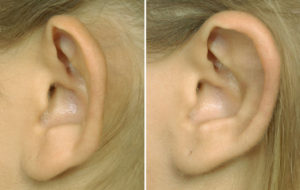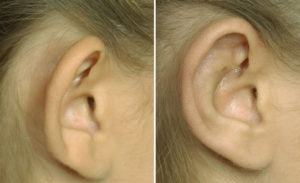Background: The protruding ear stands out from the side of head in an exaggerated fashion which is what makes it too visible. One of the features of a good looking ear is that it does not stand out in any conspicuous way. The increased auriculocephalic angle of the protruding ear is not due to a cartilage deficiency in volume. Rather the ear has a normal amount of cartilage but it just does not have the right shape.
Reshaping of the protruding ear through otoplasty surgery involves a variety of cartilage manipulation techniques. One of these and the one that is inherent in about every such ear surgery is the creation of a more defined antihelical fold. This is a natural fold in the ear that is the secondary cartilage fold that sits just inside the outer helical fold. Its relevance to the protruding ear is that when this fold of ear cartilage is absent or ill-defined the outer edge of the ear sticks out further.
While the results from otoplasty surgery for the protruding ear are always shown from the front or back view, it is also important to consider what the ear looks like from the side view. This has relevance during surgery as if an overcorrection occurs it can also be appreciated by an inadequate lengthening of the ear from front to back. (tragus to outer helix)

As the ear is pulled back further inward to the sides of the head by helical rim repositioning, the length of the ear from front to back (tragus to helical rim) increases. This anteroposterior ear change should look natural and not ‘scrunched’ which is a sign of over correction.
Highlights:
1) Traditional otoplasty surgery is about reducing the protrusion of the ear as seen in the frontal view.
2) Most reshaping procedures for the protruding ear involves creating a more defined anti helical fold.
3) The side view of the reshaped ear in otoplasty shows an increased length of the ear from front to back.
Dr. Barry Eppley
Indianapolis, Indiana



